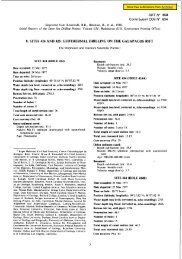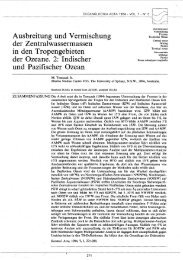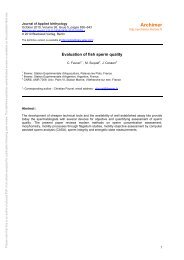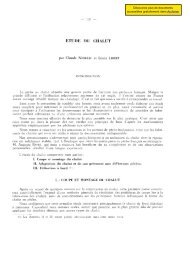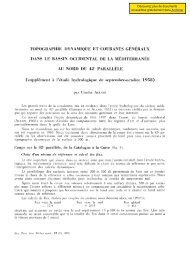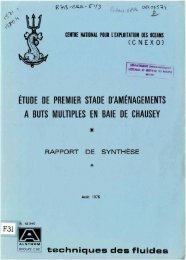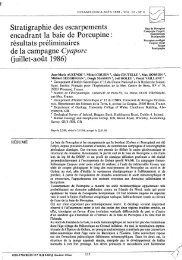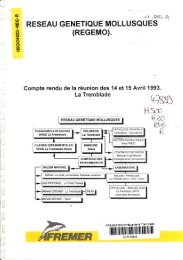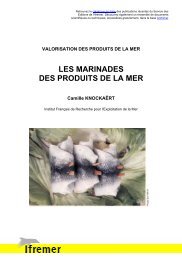Contribution à l'étude de virus de mollusques marins apparentés ...
Contribution à l'étude de virus de mollusques marins apparentés ...
Contribution à l'étude de virus de mollusques marins apparentés ...
Create successful ePaper yourself
Turn your PDF publications into a flip-book with our unique Google optimized e-Paper software.
HERPESVIRUSES ASSOCIATED WITH MORTALITIES AMONG PACIFIC OYSTER, IN FRANCE<br />
Host species Size References<br />
Capsids Enveloped virions<br />
C. virginiea 70/90 nm 1 161<br />
C. gigas 70±2.Dnm 90 ± 5.0 nm 1121<br />
C. gigas 97 ± 4.0 nm 131 ± 9.0 nm 1101<br />
O. edulis BOnm 160/1BOnm 141<br />
C. gigas (lafVae) 75 ± 3.0 nm 122 ± 6.0 nm ln this report<br />
C. gigas (young spats) 75 ± 3.0 nm 121 ± 7.0"m ln thi5 report<br />
TABLE IV. - Morphological characleristics of herpcs-like <strong>virus</strong>es observed among bivalve molluscs.<br />
In<strong>de</strong>ed, it seems that the herpes-Iike <strong>virus</strong>es <strong>de</strong>tected<br />
among bivalve molluscs are not a real danger for animaIs<br />
cultured at low temperatures Iike the observations performed<br />
by FARLEY el al. [10] suggest. Thus, since 1970, no<br />
catastrophic mortalities associated with herpes-like <strong>virus</strong><br />
<strong>de</strong>tection were reported among the species C. virginica.<br />
However it seems necessary to perform regular controls<br />
for a survey of the evolution of these <strong>virus</strong> infections<br />
among C. gigas oysters.<br />
The evolution of the disease in hatchery-reared larvae<br />
with the flfst signs visible three to four days after the spond<br />
seems to point out that contamination of larvae occurs<br />
quite carly, and may result of a vertical transmission.<br />
Among the batches of 3-7 month old young oysters, the<br />
mortalities appcared sud<strong>de</strong>nly and the course of the disease<br />
was very brief in time, only a week. These reports suggest<br />
a high pathogenicity of this herpes-Iike <strong>virus</strong>, with a great<br />
infectivity in a same batch. But in the case of young spat<br />
oysters, the origin of <strong>virus</strong> contamination is uncJear.<br />
Moreover, the presence of two similar <strong>virus</strong>es among C.<br />
gigas larvae and C. gigas young oyster spat may indicate<br />
that some larvae, survivors of animais infected by herpes<br />
Iike <strong>virus</strong>es could be healthy latent carriers and express<br />
subsequently the disease un<strong>de</strong>r stressed conditions. In<br />
point of fact, four batches of herpes-Iike <strong>virus</strong> infected<br />
C. gigas young oyster spat are originating from French<br />
hatcheries and the larvae were produced in 1993. One<br />
bateh of these infected young oysters came from a hatchery<br />
in which mortalities in association witl! herpes-<strong>virus</strong><br />
<strong>de</strong>tection were observed among several breedings during<br />
the summer of 1993. The three other batehes were originating<br />
from hateheries in which no larvae sam pie was<br />
taken and no examination was ma<strong>de</strong> during their productions,<br />
So it is impossible to know if the larvae were infected<br />
or not by the herpes-Iike <strong>virus</strong> before their exit of these<br />
hateheries.<br />
Purification· and fine characterization seem to be necessary<br />
to <strong>de</strong>velop sensitive diagnosis methods for <strong>de</strong>tection<br />
of these pathogens <strong>de</strong>scribed among C. gigas larvae and<br />
C. gigas young oysters and to <strong>de</strong>termine relationship between<br />
these <strong>virus</strong>es.<br />
84<br />
Acknowledgements<br />
This sludy could nOI been completed without the valuable help of sorne<br />
oyster French farmers and priva te French hatcheries. The aUlhors ack.<br />
nowledge André OIË.RARD for providing biological material. Thanks to<br />
D' Henri GRIZEL for critical comments on the manuscript. This research<br />
\Vas supported in part by the Conseil Général <strong>de</strong> la Charente-Maritime.<br />
References<br />
1. - AWERMAN (D.J.) : Shellfish diseases, past, present and future.<br />
Ill: Proc. I1th Ann. Conf. Sellfish Assoc. Great Brilain, 1980,<br />
p. 30-40.<br />
2. - BUCHANAN (J.A.) and RICHARDS (R.H.) : Herpes-like <strong>virus</strong><br />
diseases of marine organisms. Proe. R. Soc. Edimb., 1982,810,<br />
151·168.<br />
3. - CAMPADELU-FuIME (O.), FARABEGALI (F.), DI GAETA (S.) and<br />
ROIZMAN(B.) : Origine of unenveloped capsids in the cytoplasm<br />
of eells infected with Herpes Simplex Virus I. J. Virol., 1991,<br />
65, 1589-1595.<br />
4. - COMPS (M.) and DUTHolT (J.P.) : Infection virale associée <strong>à</strong> la<br />
« maladie <strong>de</strong>s branchies» <strong>de</strong> l'huître portugaise, Crassostreo<br />
angula/a LmK. CR. Acad. Sei., 1976,283 D. 1595-1596.<br />
5. - COMPS (M.), BONAMI (J.R.), VAGO (C.) and CAMPILLO (A.) :<br />
Une virose <strong>de</strong> l'huître portugaise (Crassos/rea angulala LMK).<br />
C.R. Acad. Sei., 1976, 282 D, 1991·1993.<br />
6. - COMPS (M.) and BONAMI (J .R.) : Infection virale associée <strong>à</strong> <strong>de</strong>s<br />
mortalités chez l'Huître Crassostrea gigas Thunberg. C.R. Acad.<br />
Sei., 1977,285 D, 1139-1140.<br />
7. - COMPS (M.) and COCHENHEC (N.) : A herpes-like <strong>virus</strong> from the<br />
European oyster Os/rea edulis. J. [nver/ebr. Pothol., 1993,62,<br />
201-203.<br />
8. - DARGAN (D.l.) : The structure and assembly of herpes-<strong>virus</strong>es.<br />
1" : Electron microscopy of proteins, 5 Viral structure. J .R.<br />
HARR IS (ed). Aca<strong>de</strong>mic Press, New York, 1986, p. 359-437.<br />
9. - ElSTON (R.) : Virus-Iîke parti<strong>de</strong>s associated with lesions in larval<br />
Pacific oysters (Crassos/rea gigas). J./nvertebr. Palho!.. 1979.<br />
33,71-74.<br />
10. - FARlEY (C.A.), BANFIElD (W.O.), KAsNIC (G.) and FOSTER<br />
(W.S.) : Oyster Herpes-type <strong>virus</strong>. Science. 1972, 178,759-760.<br />
Il. - FURLONG (O.), SWIFT (A.) and ROIZMAN (B.) : Arrangement of<br />
herpes <strong>virus</strong> <strong>de</strong>oxyribonucleic acid in the core. J. V;rol., 1972,<br />
10, 1071-1074.<br />
12. - HEDRICK (R.P.), GRAFF (J.M.), OKJHIRO (M.S.) and Mc<br />
DOWELL (T.S.) : Herpes <strong>virus</strong>es <strong>de</strong>tected in papillomatous skin<br />
growths of Koï carps (Cyprinus carpio). J. Wild. Dis., 1990, 26,<br />
576-581.<br />
13. - HEDRICK (R.P.) and SANO (f.) : Herpes<strong>virus</strong>es of fish. ln : Viruses<br />
of lower vertebrales. V. AHNE, E. KURSTAK (eds). SprÎnger<br />
Verlag, Berlin, 1989, p. 161 -170.<br />
14. - HINE (P.M.), WESNEY (B.) and HAY (8.E.) : Herpes<strong>virus</strong> associated<br />
\Vith mortalities among hatchery-reared larval Pacific o)'ster<br />
Crassosfrea gigas. Dis. aqllat. Org., 1992, 12, 135-142.<br />
741



